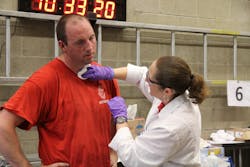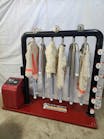Cleaning and Decon Considerations after the Fire
Following is Part 3 of the IFSI research supplement, sponsored by Globe. Download the full PDF of the supplement here.
Also, view the 10 Considerations Related to Cardiovascular & Chemical Exposure Risks supplement via Firehouse’s proprietary digital platform Clarity, which includes additional content and videos, here.
#7. PPE and skin contamination
As part of this study, we measured the amount of PAH contamination on turnout jackets and skin following the structure fire responses. As expected, contamination levels varied by job assignment. We found higher contamination on turnout jackets worn by attack and search crews, followed by overhaul crews and then outside vent and command/pump operators. Just by looking at it, you might expect that the gear worn by the overhaul crew was most in need of cleaning due to the drywall dust, but it had much less PAH contamination than the interior crews’ gear. Without gross decon being performed, contamination levels increased on turnout jackets with successive use in fires.
A critical new insight from this study was that glove contamination was also abundant. On one pair of gloves (worn by a firefighter assigned to search), we measured a variety of flame retardants added to household furnishings and products. Results from the analysis of other gloves are pending. However, it is likely that positions requiring handling of burnt items (overhaul) and interior operations (attack and search) will see substantial glove contamination. Like PAHs, certain brominated flame retardants are persistent and will remain on clothing for years unless removed by decontamination or laundering.
Skin contamination with PAHs followed a similar pattern. We measured higher PAH levels on the hands of firefighters assigned to fire attack (135 µg/m2) and search (226 µg/m2) than other positions (<11 µg/m2). Importantly, several outside vent firefighters had quite high neck exposure (half the group exceeding 30.5 µg/m2), most likely from inconsistent use of hoods. However, attack and search firefighters had the highest maximum levels of exposure on the neck (1080 and 780 µg/m2, respectively). Knowledge of PPE contamination and dermal exposures by position may be useful to decision-makers in prioritizing decontamination/cleaning procedures and policies.
#8. Gross decon
We also wanted to measure the effectiveness of gross on-scene decon of turnout gear following the structure fires. Three types of decon methods were evaluated: 1) air-based decon with a modified electric leaf-blower; 2) dry-brush decon with a stiff-bristled brush; and 3) wet-soap decon with water and dish soap applied to the turnout gear, scrubbed with a brush and then rinsed. Of the three types of decon, wet-soap decon was by far the most effective, removing an average of 85 percent of PAH contamination present on turnout gear after firefighting.
Although we do not know how this compares to water-only decon, we suspect that the dish soap (containing a surfactant) was useful for removing fat-soluble compounds, like PAHs. In situations where turnout gear cannot be immediately laundered (or prior to laundering), wet-soap decon can be an effective way of removing contamination. Further research is needed to determine the effectiveness of wet-soap decon against other contaminants, such as flame retardants, and how wet-soap decon compares in terms of effectiveness and PPE degradation to laundering.
#9. Hood laundering
Unlaundered Nomex sock hoods worn by firefighters for four structure fire responses were tested for residual flame retardants and PAHs that were embedded in the fabric and compared to similar hoods that were laundered after each fire.
The laundered hoods in our study certainly looked cleaner. However, our preliminary results indicate that while most of the PAH contamination was removed, much of the brominated flame-retardant contamination remained. Additionally, a 2016 study reported that a high percentage (>80 percent) of brominated flame retardants were retained in laundered fabrics. The authors of this study (Saini and colleagues) attributed this finding to the difficulty of removing fat-soluble compounds from fabrics using traditional laundering practices.
While many contaminants will be removed from hoods via laundering (extractors with commercial detergent), these results suggest that some fat-soluble compounds, like brominated flame retardants, may not be effectively removed, which could present a prolonged exposure for firefighters. How much this exposure pathway contributes to systemic exposures in firefighters is yet to be determined.
It is important to determine whether more effective means of laundering exist and if chemicals contaminating the hoods can transfer to other hoods or items during laundering (cross-contamination). It is also possible that new particle blocking hoods could lessen the amount of contamination available to contact the neck skin as contamination may be isolated to the exterior of the hood.
#10. PPE off-gassing
During fireground use, personal protective ensembles will absorb volatile organic compounds (VOCs). Once the gear is removed from the IDLH environment, it will begin to release VOC back to the air through a process called “off-gassing.” If turnout gear is worn or stored on the inside of an enclosed apparatus cabin during the ride back to the station (or personally operated vehicle heading home), firefighters are likely to be exposed to several airborne VOCs, including known carcinogens like benzene.
We measured the levels of VOCs and HCN off-gassing from turnout gear before and after the fires as well as after decon had been completed. Six sets of turnout gear were placed inside an enclosed structure about the size of a modern apparatus cab. The off-gas levels increased after firefighting, but were well below applicable short-term exposure limits. The off-gas levels returned to near background concentrations after gross on-scene decon (regardless of type).
However, similar “near background” levels were measured simultaneously from turnout gear that did not undergo decontamination. This suggests that the 17–36 minutes required to perform decon was enough for the majority of the VOCs to off-gas naturally. It should be noted, however, that semi-volatile compounds (with higher molecular weights than VOCs) may take much longer to off-gas and were not evaluated in our study.
Because of this potential route of exposure, turnout gear should be left outdoors to off-gas, bagged and/or transported in an unoccupied compartment on the apparatus or other vehicle.
More from the Supplement:
- Introducing the 10 Considerations Related to Cardiovascular & Chemical Exposure Risks
- Tactical Considerations Related to Occupant Exposure
- Exposure Considerations for Outside and Overhaul Operations
- Concluding Messages—and What's Next
Rehab & Hygiene—a Critical Combination
Get out, get cool, get hydrated and get clean! Decon your face and neck as soon as possible after exiting the building.
"Fireground rehab policies have been evolving, both in their development and their adoption, over the last several years. Hydration, rest/recovery, cooling, nourishment and medical monitoring continue to be essential aspects of rehab, with a recently added focus on firefighter decontamination. It is clearly time to add rehab/decon/hygiene as an integrated and essential fireground function.
Firefighters reporting to formalized rehab should remove contaminated PPE and begin the cleaning process whenever possible, taking into consideration ambient temperature conditions and/or rehab being conducted outside of an enclosed area. Protecting against secondary contamination from PPE off-gassing in an enclosed area is now recognized as a serious safety consideration.
After firefighters doff their PPE, they should take steps to decontaminate their skin, particularly on their hands, face and neck. If a firefighter has contaminated hands, this material can transfer to other areas of the body when wiping away sweat or using the bathroom. Furthermore, nutrition provided during rehab commonly requires eating with the hands. Without proper hand hygiene, this could result in the inadvertent ingestion of contaminants."
— Craig A. Haigh, Fire Chief, Hanover Park, IL, Fire Department
The “Salty” Firefighter Conundrum
Many bosses can be very focused on having their crews diligently clean their apparatus every morning, polish tools and conduct station inspections, but then overlook dirty gear, unnecessary exposures and soot-covered faces.
"When a new firefighter goes through their recruit academy, we often stress the importance of maintaining clean tools and apparatus as a critical behavior to instill early in a firefighter’s career. If tools are not cleaned or hose is loaded in a sloppy manner, these are commonly taken as indicators of a lack of focus on the details from the new firefighter.
It is important that firefighters take pride in the appearance and readiness of tools and apparatus. However, this pride is not always translated into cleaning of the firefighter’s own personal PPE. The “salty” appearance of well-used helmets, coats and gloves may be taken as a badge of honor, as opposed to an indication of an unnecessary exposure.
While in recent years the fire service has made great strides to address this apparent conundrum, the irony of this double standard is still present in many places. It’s time for all of us to be role models and take the same pride in cleaning our bunker gear that we do to ensure our tools are free from debris and rust."
— Todd Harms, Fire Chief, Sacramento, CA, Metropolitan Fire District
Leadership—Let’s Make Sure It Is by Example
How can a fire chief set the example for their firefighters with regards to cancer or cardiac risks?
"With cancer rates in the fire service hitting what I feel is a critical and unacceptable level, members of the fire service need to better understand the contamination that is occurring on the fireground. This research illustrates the significant contamination on the fireground and the associated hazards for both interior and exterior firefighters. Better understanding of these hazards and continued research on how to limit exposure and perform decontamination procedures is vital, as is the education that will help ensure compliance with best practices.
A fundamental change must occur in the fire service. Decon should be required after all fireground operations, and the wearing of soiled contaminated gear can no longer be tolerated. Individual members must make the commitment to properly wear their gear, wear their SCBA throughout the fire and overhaul, and commence gross decon upon exiting the IDLH environment, followed by a prompt shower upon return to quarters.
Most importantly, we as company and command officers must do these things ourselves to make sure we lead by example. We owe it to ourselves and each other to make this a priority."
— George Healy, Deputy Chief, Fire Department of New York
2. Fent, K.W., Alexander, B., Roberts, J., et al. “Contamination of firefighter personal protective equipment and skin and the effectiveness of decontamination procedures.” Journal of Occupational and Environmental Hygiene. 2017. tinyurl.com/DOI-contamination.
Stephen Kerber
Stephen Kerber is the director of the UL Firefighter Safety Research Institute (FSRI). He has led fire service research and education in the areas of ventilation, structural collapse and fire dynamics.
Dr. Denise Smith
Dr. Denise Smith is a professor at Skidmore College and a research scientist at the Illinois Fire Service Institute (IFSI). She conducts research on the heat stress and cardiovascular strain associated with firefighting, pathoanatomic cause of firefighter fatalities, and strategies to increase performance and decrease cardiovascular events in the fire service.
Dr. Kenneth Fent
Dr. Kenneth Fent is a research industrial hygienist at the National Institute for Occupational Safety and Health (NIOSH). Much of his research has focused on characterizing firefighters’ exposures to chemical agents, including carcinogens, and evaluating the effectiveness of practices intended to reduce exposures.






